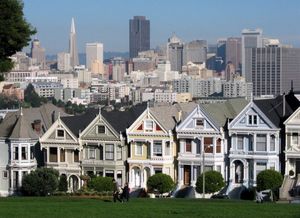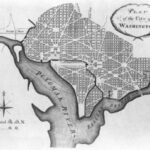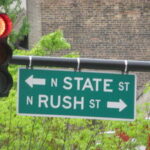If you have been to San Francisco, California, you would have not truly seen San Francisco if you haven’t seen or experienced the Victorian architecture. Oftentimes, visitors of this great city have toured the streets where beautiful Victorian homes can be seen. Along Alamo Square there is a row of six beautiful picture perfect Victorian homes standing proudly. These homes are popularly called “Painted Ladies” of San Francisco due to their multi-colored exterior drawing attention to the elements of the Victorian architectural design. This street has also been dubbed as “postcard row”in reference to the widely use of these famous Victorian homes in post cards from San Francisco.
Seeing these beautiful Victorian homes gives you a glimpse of the bygone era- the Victorian era. Visitors who would want to learn more about its rich history, the Victorian lifestyle, and architecture can join the regular Victorian Walking Tour every Sunday at 2:00pm (check www.sfcityguides.org for more information about this tour). In this article I will discuss some of the aspects of Victorian architecture as seen in the Victorian homes of San Francisco.
Victorian Era:
The term “Victorian Era” happened during the reign of Queen Victoria of England. It describes things and events that happened during her reign which was from 1837 through 1901, lasting beyond Victoria’s death until the beginning of World War I in 1914. The Victorian era was filled with things new. This era is when we have seen a lot of new inventions, changes in culture, politics and the start of the industrial society.
In America, Victorian values were adopted through its English friends who brought along the fashions and lifestyle from their homeland.
During this era, people were more dressed up. Women especially wore elegant clothing with a lot of frills and laces. They were expected to look very proper and elegant at all times. Even the young children, both girls and boys wore fancy clothing most of the time. Emphasis in fashion and proper demeanor in public was the norm in this era.
Victorian Architecture:
Prior to the Victorian era, the most popular style of architecture was the Greek Revival. With its simplicity and dignified appearance, the Greek Revival style was used almost exclusively for public buildings. By the time Queen Victoria as put into throne, the popularity of the Greek Revival style started to wane. In 1840s the Greek style was no longer fashionable for a private residence. Cottages were built as summer residences had no insulation, yet the underlying surfaces were of solid construction. Most floor plans were similar with the exception of the façade where additional ornamentation was added as construction progressed. These homes had neither kitchens nor bathrooms. The additions often house the kitchens and baths.
The earlier homes built in England were built of stone and enhanced with decorative “stone tracery”. Only the wealthy could afford the cost of building Gothic stone mansions which required the labors of highly skilled stone carvers. Eventually, the use of wood replaced the stone tracery, which then became the “Carpenter Gothic” which was more commonly used as this style was brought to America.
The use of ornate wooden detail is a characteristic of the Victorian architecture. Each carpenter had his own ideas and employed his own fanciful designs. The American Carpenter Gothic style is characterized by steep gables and pointed windows. Traditionally, these so called “American Gothic” were built vertically which is typical of the Victorian design. These homes mark the real beginning of modern architecture. These homes were planned from the inside out and the layout of the rooms and the traffic pattern determines the outward look. Inside there are several enclosed rooms, as if there is a surprise at each turn.
Between 1825 and 1900 became the Victorian architectural period. Inspirations in building these beautiful homes came from nature, history, geometry, theory and personal preferences. Architects and designers had used their creative ideas and added them to the simplicity of the original design intended. Although early Victorian structures were relatively simple in style after the Civil War the style became more complicated, elaborate, and flamboyant. This is mainly due to the influence of the industrial revolution. The builders and architects combined styles as they saw fit which oftentimes resulted in a stunning visual effect. The combination of several architectural styles made up what is collectively called “Victorian. These include Italianate, Second Empire, Stick-Eastlake, and Queen Anne. Italianate style structures have flat roof lines, corniced eaves, angled bay windows and Corinthian-columned porches. Stick-Eastlake structures often include square bays, flat roof lines and free-style decorations. Queen Anne structures have a gabled roof, shingled insets, angled bay windows under the gable and on occasion a tower.
The early Victorian homes were painted in white, beige or gray color using a single color all over the exterior of the home. However, in the latter part of the nineteenth century, many people were painting their houses in lighter, brighter colors. By 1887, homeowners were using different colors to highlight the wooden decorations of the exterior of the home. The vibrant colors are one of the more easily identifiable features of Victorian architecture today. . The interior of Victorian homes were equally as ornate as the exterior. The interior architecture used a lot of ornate decorative relief and moldings as well as wall coverings. Victorian houses were often cluttered, not a single room is spare of any ornamentation, and even the ceilings have been decorated with fresco painting.
From 1870 to 1906 thousands of Victorian homes were built in San Francisco, California. The abundance of coastal redwood contributed to the mass production of these beautiful homes. These homes were built cheaper; furthermore the use of redwood was very ideal in resisting rot and termites. Redwood was also a material which was easy to use. Many of these houses were lost in the great fire that followed the 1906 earthquake, and others were torn down over the years to make way for new development. However, thousands of these elegant homes still grace the streets of San Francisco just waiting to be discovered and admired.
During the late 19th to the early 20th century (around 1895 to 1915), middle-class tastes turned away from the clutter and closed off rooms of the Victorian home turning to simpler, open, and flexible spaces. The living room replaced the parlor. Natural wood furniture and interiors displaced the artificial, upholstered and multi-layered look typical of the Victorian home. During this period the working-class and middle-class homes reflected contrasting material standards.
Today many homes from the Victorian architectural period still stand and are considered among the most beautifully rustic in almost any neighborhood as in Alamo Square of San Francisco, California where six restored Victorian homes called the “Painted Ladies” still grace us with their beauty.







